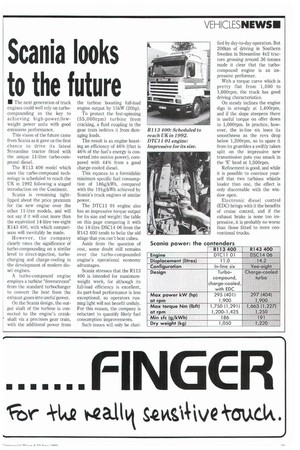Scania looks to the future
Page 13

If you've noticed an error in this article please click here to report it so we can fix it.
• The next generation of truck engines could well rely on turbocompounding as the key to achieving high-power/lowweight power units with good emissions performance.
This vision of the future came from Scania as it gave us the first chance to drive its latest Streamline tractor fitted with the unique 11-litre turbo-compound diesel.
The R113 400 model which uses the turbo-compound technology is scheduled to reach the UK in 1992 following a staged introduction on the Continent.
Scania is remaining tightlipped about the price premium for the new engine over the other 11-litre models, and will not say if it will cost more than the equivalent 14-litre vee-eight R143 400, with which comparisons will inevitably be made.
However, the company clearly rates the significance of turbo-compounding on a similar level to direct-injection, turbocharging and charge-cooling in the development of modern diesel engines.
A turbo-compound engine employs a turbine "downstream" from the standard turbocharger to convert the heat from the exhaust gases into useful power.
On the Scania design, the output shaft of the turbine is connected to the engine's crankshaft via a precision gear train, with the additional power from the turbine boosting full-load engine output by 15kW (20hp).
To protect the fast-spinning (55,000rpm) turbine from cracking, a fluid coupling in the gear train isolates it from damaging loads.
The result is an engine boasting an efficiency of 46% (that is 46% of the fuel's energy is converted into motive power), compared with 44% from a good charge-cooled diesel.
This equates to a formidable minimum specific fuel consumption of 186g/kWh, compared with the 191g/kWh achieved by Scania's truck engines of similar power.
The DTC11 01 engine also has an impressive torque output for its size and weight: the table on this page comparing it with the 14-litre DSC14 06 from the R143 400 tends to belie the old adage that you can't beat cubes.
Aside from the question of cost, some doubt still remains over the turbo-compounded engine's operational economy advantages.
Scania stresses that the R113 400 is intended for maximumweight work, for although its full-load efficiency is excellent, its part-load performance is less exceptional, so operators running light will not benefit unduly. For this reason, the company is reluctant to quantify likely fuel consumption improvements.
Such issues will only be clad lied by day-to-day operation. But 200km of driving in Southern Sweden in Streamline 4x2 tractors grossing around 36 tonnes made it clear that the turbocompound engine is an impressive performer.
With a torque curve which is pretty flat from 1,000 to 1,600rpm, the truck has good driving characteristics.
On steady inclines the engine digs in strongly at 1,400rpm, and if the slope steepens there is useful torque on offer down to 1,000rpm. In practice, however, the in-line six loses its smoothness as the revs drop below 1,200rpm, so to spare it from its grumbles a swiftly taken split on the impressive new transmission puts you smack in the 'E' band at 1,500rprn.
Refinement is good, and while it is possible to convince yourself that two turbines whistle louder than one, the effect is only discernable with the window open.
Electronic diesel control (EDC) brings with it the benefits of cruise control, and if the exhaust brake is none too impressive, it is probably no worse than those fitted to more conventional trucks.




































































































